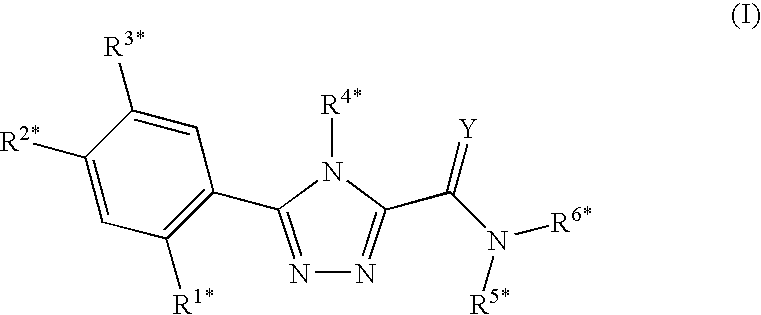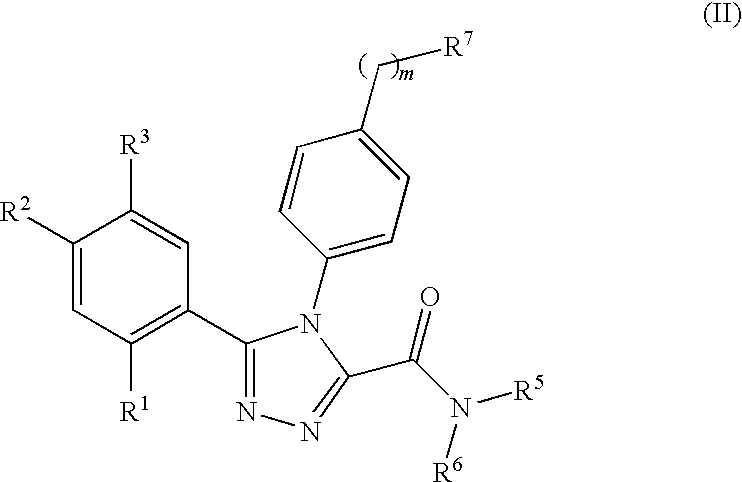Triazole compounds that modulate HSP90 activity
a technology of hsp90 activity and triazole, which is applied in the direction of antibacterial agents, drug compositions, immunological disorders, etc., can solve the problems of unsatisfactory current chemotherapy, unfavorable treatment results, and inability to fully implement a therapeutic agent that acts on one molecular targ
- Summary
- Abstract
- Description
- Claims
- Application Information
AI Technical Summary
Benefits of technology
Problems solved by technology
Method used
Image
Examples
example 1
Synthesis of Compound 95
[0843][0844]STEP-1: To the solution of compound 1 (16.7 g, 73 mmol) and NaHCO3 (18.5 g, 219 mmol) in anhydrous DMF, was added sodium chloroacetate 2 (12.8 g, 109.5 mmol). After the addition, the mixture was stirred at 75° C. for 2 h, and to the resultant mixture, was added compound 3 (15 g, 73 mmol) in portion at the same temperature and the solution was stirred for 4 h. The mixture was cooled to room temperature and poured into ice water. The resultant precipitate was filtered, washed with water and dried to give target compound. Quantity: 20 g; yellow solid; yield: 75%.[0845]STEP 2: To a suspension of compound 4 (13.7 g, 33.17 mmol) in THF (150 ml) was add 1,1′-carbonyldiimidazole (5.37 g, 33.17 mmol) portion-wise at 0° C. and the resultant mixture was stirred at room temperature for 2 h. Water was added and organic layer separated and aqueous layer was extracted by ethylacetate. The organics were combined, washed with water, brine and dried over Na2SO4. Th...
example 2
Synthesis of Compound 129
[0995]
[0996]4-(morpholinomethyl)aniline (577 mg, 3.0 mmol) was added to sulfinylbis((2,4-dihydroxy-5-isopropylphenyl)methanethione) (746 mg, 1.7 mmol) in 10 ml DMF at rt. It was stirred for 2 h and then added into 20 ml water. The pH was adjusted to 7-8 and then extracted with ethyl acetate. The combined extracts were dried over Na2SO4, filtered and the solvent removed. The crude product was purified by chromatography on silica with DCM / MeOH (5-10%) to yield 1.23 g (2.8 mmol). The thioamide (289 mg, 0.66 mmol) was then added to hydrazinecarboxamide (147 mg, 1.32 mmol) and mercury chloride (210 mg, 0.79 mmol) in 8 ml DMF. Pyridine (244 ul, 3.0 mmol) was added and the mixture heated in a microwave reactor at 120° C. for 2 h. The crude mixture was filtered, concentrated and purified by chromatography on silica with DCM / MeOH (0-10%) to yield 28 mg (0.07 mmol) 4-(5-amino-4-(4-(morpholinomethyl)phenyl)-4H-1,2,4-triazol-3-yl)-6-isopropylbenzene-1,3-diol.
[0997]NMR (...
example 3
Synthesis of Compounds 127 and 128
[0999]
[1000]The benzylether [5-(2,4-bis(benzyloxy)-5-isopropylphenyl)-4-(1-(2-(methylamino)ethyl)-1H-indol-5-yl)-4H-1,2,4-triazol-3-ol; 294 mg, 0.5 mmol) was dissolved in 6 ml degassed ethyl acetate and ethanol (1:1). 50 mg Pd / C (10%) was added and the mixture stirred under hydrogen (balloon) at rt for 6 h. After filtration the solvent was removed and the crude purified by chromatography on silica with DCM / MeOH (5-20%) / NH4OH (0.5%) to yield 203 mg (0.5 mmol) 4-(5-hydroxy-4-(1-(2-(methylamino)ethyl)-1H-indol-5-yl)-4H-1,2,4-triazol-3-yl)-6-isopropylbenzene-1,3-diol. This amine (203 mg) was added to 4-(2,5-dioxo-2,5-dihydro-1H-pyrrol-1-yl)butanoic acid (110 mg, 0.6 mmol), EDC (154 mg, 0.8 mmol) and HOBt (108 mg, 0.8 mmol) in 9 ml DCM / DMF (2:1) at rt. The mixture was stirred for 12 h and then ethyl acetate and water added. The aq. Phase was extracted twice with ethyl acetate and the combined organic extracts washed with brine and dried over MgSO4. The c...
PUM
 Login to View More
Login to View More Abstract
Description
Claims
Application Information
 Login to View More
Login to View More - R&D
- Intellectual Property
- Life Sciences
- Materials
- Tech Scout
- Unparalleled Data Quality
- Higher Quality Content
- 60% Fewer Hallucinations
Browse by: Latest US Patents, China's latest patents, Technical Efficacy Thesaurus, Application Domain, Technology Topic, Popular Technical Reports.
© 2025 PatSnap. All rights reserved.Legal|Privacy policy|Modern Slavery Act Transparency Statement|Sitemap|About US| Contact US: help@patsnap.com



